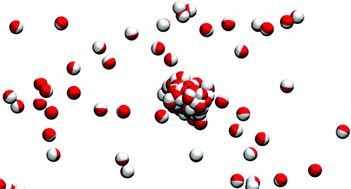
|
|
|
JPH > JPH approachJPH approach: combining theory and simulation
Following in the footsteps of Berni Alder, the use of minimal models to understand what is going on, and to test analytical theories trying to capture this in mathematical formalism, has always fascinated Jean-Pierre and motivated his interest in simulation. Starting with his pioneering thesis research under the supervision of Loup Verlet on the phase diagram of Lennard-Jones systems, his lifelong activity in the field has not only made crucial contri- butions to the theory of liquids but also helped establishing computer simulation as a new and unique approach in physical science, next to theory and experiment. Examples of his clever combination of analytical approaches and numerical simulation include: His work on freezing of simple fluids, both by Monte Carlo simulations and classical density functional theory; the work on structure and dynamics of charged fluids and plasmas, with results still widely used in astrophysical applications; His formulation of self consistent integral equa- tions, which allowed extension of these methods to strongly coupled fluids and some of the first simulations of dynamical properties of supercooled fluids, which contributed to a better understanding of the glass transition. More recently Jean-Pierre extended his interest to the field of complex liquids and granular matter, and made important contributions to the theory of charged and neutral colloids, polymer solutions and block copolymer self-assembly. Another aspect of Jean-Pierre’s contribution is on the pedagogical side as a great teacher and mentor. While teaching and working on his research in the three great schools he joined during his career, first in Paris, later in Lyon and then in Cambridge, he has educated a succession of outstanding students and postdocs who went on to become successful scientists many of them continuing to apply computer simulation as a theoretical research tool. His well-known book Theory of Simple Liquids with Ian McDonald has also played a vital role. While not directly concerned with computer simulation techniques, this book clearly showed the power of the approach in statistical mechanical theory and analysis and has been an inspiration for all. Three editions have now appeared (the first one more than 30 years ago, the third just last year). It has now been joined by a new book Basic Concepts for Simple and Complex Liquids with Jean-Louis Barrat. which again places molecular simulation as an equal among the traditional methods of science. |
 Finding answers to theoretical questions about liquids was arguably the most important driving force behind the birth and early development of computer simulation in the fifties and sixties. The liquid state of matter is indeed mysterious, stabilized by a delicate balance between thermal disorder and cohesion and therefore the prime object of study for statistical mechanics. However, as described in many textbooks on liquids, in particular the classic text by Jean-Pierre Hansen coauthored with Ian McDonald, the theory community was rather stuck before the invention of computer simulation not really knowing from where to start (or, in more technical terms, which reference state to use). Computer simulation pointed the way for the development of accurate analytical methods for treating liquids by providing precise “experimental” data for simple well defined model systems against which the predictions of these methods could be tested. However, numerical simulation is more than a method of observation at the atomistic level. Equally important, certainly from the point of view of a theorist such as Jean-Pierre, is its role as a tool for conceptual development. It allows to strip interatomic potentials to the bare minimum needed to understand the essence of behaviour of liquids. One of the best examples of this approach is the work of Berni Alder showing that the minimal model for a liquid is a system of hard spheres.
Finding answers to theoretical questions about liquids was arguably the most important driving force behind the birth and early development of computer simulation in the fifties and sixties. The liquid state of matter is indeed mysterious, stabilized by a delicate balance between thermal disorder and cohesion and therefore the prime object of study for statistical mechanics. However, as described in many textbooks on liquids, in particular the classic text by Jean-Pierre Hansen coauthored with Ian McDonald, the theory community was rather stuck before the invention of computer simulation not really knowing from where to start (or, in more technical terms, which reference state to use). Computer simulation pointed the way for the development of accurate analytical methods for treating liquids by providing precise “experimental” data for simple well defined model systems against which the predictions of these methods could be tested. However, numerical simulation is more than a method of observation at the atomistic level. Equally important, certainly from the point of view of a theorist such as Jean-Pierre, is its role as a tool for conceptual development. It allows to strip interatomic potentials to the bare minimum needed to understand the essence of behaviour of liquids. One of the best examples of this approach is the work of Berni Alder showing that the minimal model for a liquid is a system of hard spheres.
